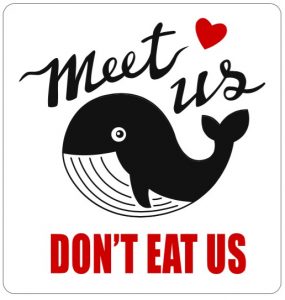Direct Threats to Whales – and Potential Solutions
Here at Special Tours, we take joy in showing off the wonderful animals that feed in the bay of Faxaflói throughout the year. As a whale-friendly company, we are strongly committed to the idea of sustainable tourism, and we always do our best to minimize our disturbance on these amazing mammals on our tours. Protecting whales, dolphins, and porpoises (collectively known as cetaceans), however, also involves knowing what threats they face around the world. Unfortunately, whales face a variety of threats, which are mainly due to human activities. To raise awareness, we would like to highlight some of the main direct threats to whales and talk about what you can personally do to help reduce these impacts.
Plastic Pollution
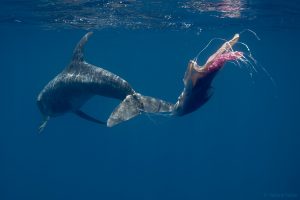
Photo by Andrew Sutton, WDC Ambassador.
Every year, millions of tons of plastic enters the oceans around the world. The main land-based source of this pollution is runoff from landfills next to bodies of water. Rainwater causes trash to flow into rivers, which then flow into the ocean. Meanwhile, out at sea, illegal dumping from ships contributes a lot of pollution as well. All this trash can be extremely noticeable in some spots – for example, there is a massive garbage patch in the north central Pacific Ocean that has reached a staggering size, as much as 1.6 million square kilometers. That’s more than 15 times the size of Iceland!
This plastic can take extraordinarily long to break down – for example, a normal plastic shopping bag can take up to 1000 years! When plastics break down, they create tiny particles called micro-plastics which then circulate throughout the ocean, making their way into the food chain and are eventually eaten by whales – or even humans. This is a large problem because the chemicals used to manufacture these plastics can be toxic, and some are known to cause diseases and birth defects. If whales ingest large pieces of plastic directly, it can cause them to choke, or fill up their stomachs and lead to starvation.
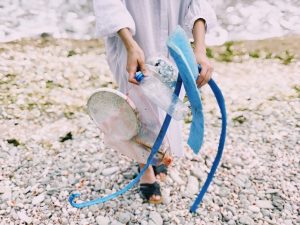
What can you do?
If you stop the use of single-use plastics, such as straws, cutlery, and shopping bags, you can not only help reduce the demand for these products, but also lower your personal contribution to this plastic nightmare. Instead of plastic straws, choose easily biodegradable paper straws, or reusable metal ones. Instead of plastic cutlery, keep a metal fork and knife in your car, or you could even choose biodegradable, plant-based “plastic” cutlery, such as by Vegware. And bring a sturdy, reusable shopping back with you to the supermarket.
If you want to go a step further, you can ask businesses you shop at, and restaurants you eat at, to consider switching away from single-use plastics. Those plastic take-out containers might keep your food safe on the trip home, but thick paper cartons will do the job just as well. And if you’re out for a walk and notice a plastic six-pack holder or shopping bag on the ground, take the minute and place it in a nearby bin. These are small steps, but if we all follow them, then they will make an impact.
Entanglement
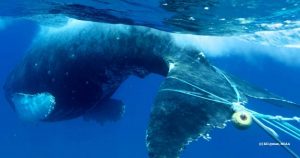
Photo of entangled humpback whale by Ed Lyman, NOAA.
Whales of all sizes are vulnerable to entanglement in fishing gear, and this risk only increases as fisheries around the world grow in size. What may happen is that a dolphin or porpoise sees fish caught in a net, and may try to eat them, getting itself entangled. Or, the thin filaments used in these nets may just not be visible to these animals, and so they become entangled by mistake. Because whales are mammals, and they must rise to the surface to breathe, this can cause these animals to drown. If they survive these entanglements, the fishing gear can leave wounds, infections, and result in scars to form.
A recent study which analyzed these scars concluded that a significant percentage of all humpback whales spotted in Icelandic waters have been previously entangled in fishing gear (Basran et al., 2018). These incidents might happen anywhere along their migration route, and they aren’t just from nets that are actively being used – whales may also become entangled in “ghost nets”, or nets that float around, unused, having been broken off or discarded carelessly. Ghost nets not only pose an entanglement threat, but also contribute to plastic pollution – see above.
The world’s smallest whale, a species of porpoise known as the vaquita, is unfortunately also the world’s most endangered whale. This is entirely due to entanglements – in their habitat, the Gulf of California in Mexico, an illegal gillnet fishing industry exists to hunt the totoaba, a large fish species. Vaquitas unfortunately become entangled very easily in these nets, causing them to drown. The most recent population estimate of this species is only 30 individuals, and so they are on the brink of extinction.
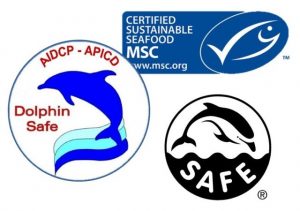
What can you do?
If you do any recreational fishing in areas where dolphins or porpoises might be found, it is important to always pull your line up if they approach the boat, and to never feed wild cetaceans. If they become very used to fishing boats, this puts them in danger of getting entangled in nets or fishing line (or even swallowing a fish with a hook in it – ouch).
If you aren’t a fisher, but you buy seafood, make sure to always look for “sustainable seafood” or “dolphin-safe” labels on the food you buy. The fishers these companies obtain their food from conduct their catches in a way that is as safe as possible.
If you are by chance a commercial fisher, then there are ways to reduce the chances of cetacean entanglement, such as affixing pingers to the nets – small devices which emit sound and make them easier for animals to detect. They are very low-cost, only about €4.50 per year per kilometer of fishing net! And soon, a type of net that includes barium sulfate should become more widely available – this compound makes fishing nets much easier to “see” using echolocation, which toothed whales use.
Noise Pollution
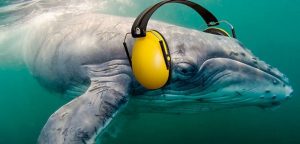
It would be nice to hand these out sometimes. Image from OceanCare.
The ocean is a noisy place! The three main sources of noise pollution in the ocean are ship noise, gas and oil exploration, and sonar from military vessels. The largest ships that sail across oceans, such as container ships, oil tankers, and cruise ships, need incredibly powerful engines to power them – some more than 100,000 horsepower, and guzzling up to 16 tons of fuel every hour. And all that machinery makes a lot of noise, in the same range that whales use to communicate. This interferes with their ability to hear, including echolocation, and can sometimes result in them being struck by ships – but more on that later.
When oil and petroleum companies scout out potential areas to place oil rigs and start drilling, they first conduct seismic surveys to analyze the geology of the seafloor to check if there could be oil underneath. The air guns used in these surveys produce incredibly loud and intense bursts of noise, meant to penetrate hundreds of kilometers into the ocean floor. And these bursts can be disastrous to marine life, killing not only cetaceans but also seals and zooplankton. Whale stranding’s are often associated with these surveys. Farther away the effects are reduced, but they can still damage whales’ ears, or cause them to stop breeding. Overall, the effects of a single seismic survey may cover 300,000 square kilometers – 3 times the size of Iceland.
Another major source of mass stranding’s is from the use of sonar by military ships, especially during exercises and practices. Sonar began to grow in popularity around World War II, when it was used mainly to locate submarines. But the frequencies used in this sonar can be very harmful to whales, either causing direct injuries such as ear damage, or causing them to panic and surface too quickly, leading to decompression sickness, like human scuba divers can get. This can especially affect beaked whales, the deepest-diving of all mammals. Dozens of mass stranding’s over the past decades have been associated with naval sonar, but because these military activities are often classified, there may be many other mysterious mass stranding’s that could have been caused by sonar as well.
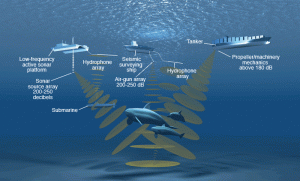
Image from NOAA.
What can we do?
Further development of renewable energy that doesn’t rely on fossil fuels, as well as reductions in these military sonar exercises, would go a long way towards making the oceans a quieter place. And if you do decide to go whale watching, either here in Iceland or elsewhere in the world, make sure to choose a company that follows all local regulations – and even better if they adhere to a Code of Conduct. These companies do their best to minimize sound production from engines and propellers while whales are in the area. The Icelandic Whale Watching Association (IceWhale) has been maintaining its Code of Conduct since 2015.
If you are the skipper of a recreational fishing boat, and dolphins (for example), happen to approach the boat, turning off your fish finder might just reduce the noise that these animals must deal with every day.
Whaling
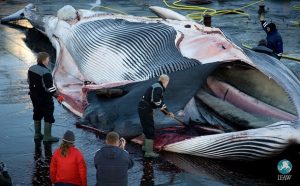
Photo of fin whale being processed, courtesy of IFAW.
Whaling as a practice has existed for thousands of years. In times of starvation, a single whale could feed a hungry village for weeks. But this whaling for survival, or “subsistence whaling,” is far different from the commercial whaling that still unfortunately exists today. The whales that swim in our seas today form just a fraction of their numbers from before commercial whaling came along. A recent estimate suggests that during the 20th century (1900-1999), nearly 3 million whales were hunted as part of commercial whaling, and hundreds of thousands more over the previous two centuries.
Today, there are only 3 countries that still allow the practice of commercial hunting: Norway, Japan, and Iceland. Here in Iceland, the 2 species that have been hunted over the past few years are the fin whale and minke whale. While the minke whale population has not been listed as threatened, fin whales have been added to the IUCN Red List of Threatened Species, and have been classified as either vulnerable, or endangered. All countries that allow commercial whaling claim to have quotas that result in sustainable catches, which would not affect the overall population long-term – but it is very difficult to estimate their population in the first place.
What can you do?
Minke whale meat is unfortunately still served in restaurants and sold in supermarkets here in Iceland. But only a minority of Icelanders still eat whale meat – the most recent survey revealed less than 2% of Icelanders eat it on a regular basis, and more 80% never eat it. Most of the demand comes from foreign visitors. While you are here, make a point to choose “whale-friendly” restaurants. Many of them have pledged to not serve whale meat, by placing a sticker in their window that says, “Meet us, don’t Eat us!”
Ending whaling in whale watching areas has already revealed noticeable impacts. In Summer 2018, when the minke whaling season stopped partway through, whale watchers in Faxaflói Bay began to see a noticeable increase in curious minke whales that would approach boats.
You can also add your name to the petition organized by the International Fund for Animal Welfare (IFAW), to help show the world that eating whale meat is indeed a dying practice: https://ifaw.is/signup/.
Ship Strikes
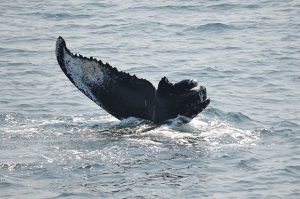
Bayou, a humpback whale spotted off the coast of Massachusetts, is believed to have been struck by a ship to produce this unique tail. Photo from Boston Harbor Cruises.
Whales being struck by boats and ships is a widespread issue that can affect any species swimming where vessels may also travel. Although in general, whales react and respond to danger very quickly, in some cases their ability to react (and escape) can be reduced. For example, if they are resting, nursing a calf, feeding, or even reproducing, they may be less aware of their surroundings and become more vulnerable to being hit by a vessel. In nearly every well-studied whale population, individuals have been found bearing the marks of ship strikes, from injured dorsal fins to scars on their backs. Unfortunately, many whales do not survive these encounters.
The North Atlantic right whale, the most endangered of baleen whales due to centuries of whaling, now faces a new threat in ship strikes. As commercial shipping increases every year, passing through their habitats, they become more at risk. And because climate change is reducing the amount of Arctic sea ice that stays throughout the year, more potential shipping routes are opening up, further adding to this risk.
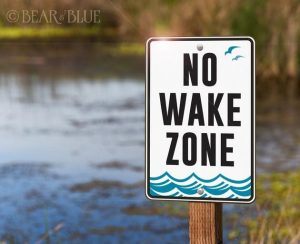
Photo from BearandBlue.com.
What can we do?
In the United States, the states of Massachusetts and California created laws in 2009 and 2013, respectively, to redirect shipping channels going through areas where many whales can be seen, in an effort to reduce ship strikes. If this continues around the world, and in other countries, then we may be well on our way to help reduce this issue.
When piloting small recreational vessels in coastal waters, make sure to always obey all posted speed limits and signs with “No Wake” warnings. Not only do these help prevent accidents with other boats, but going at a steady pace can help skippers more easily notice and avoid marine mammals such as whales, dolphins, porpoises, seals, and manatees.
Blog by Jonathan Rempel
Instagram: @jon.rempel
Special Tours Head Guide
